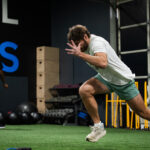Youth Soccer Performance Training Made Simple
Soccer isn’t just for the pros. Young athletes deserve proper training, too. But youth development isn’t about lifting heavy weights or running laps until exhaustion. Great youth soccer performance training builds strength, speed, and agility while keeping it age-appropriate and fun.
Let’s explore how to set young soccer players up for long-term success—without burning them out.
Why Youth Soccer Players Need Performance Training
Some parents worry that strength or speed training is “too much” for kids. But when done right, it’s not only safe—it’s essential.
Performance training for youth soccer:
-
Builds a solid movement foundation
-
Reduces injury risk as players grow
-
Boosts coordination and confidence
-
Encourages healthy habits early on
-
Enhances speed, strength, and endurance safely
According to the NSCA, youth training should focus on long-term athletic development (LTAD), not quick gains.
What Ages Should Start Soccer Performance Training?
Youth soccer performance training can start as early as age 7 or 8—but it must be tailored to their developmental stage.
Here’s a general guide:
-
Ages 7–10: Focus on fun, coordination, and basic bodyweight movement
-
Ages 11–13: Introduce strength, speed, and agility drills (no max loads)
-
Ages 14–17: Begin structured resistance and position-specific training
Training should be supervised, progressive, and always emphasize proper form.
Core Elements of Youth Soccer Performance Training
1. Movement Skills
Develop foundational athletic movements:
-
Jumping
-
Skipping
-
Crawling
-
Rolling
-
Running mechanics
These build coordination, spatial awareness, and injury resilience.
2. Speed and Agility
Train quick feet, reaction time, and change of direction:
-
Ladder drills
-
Cone zig-zags
-
Reaction-based games
-
Short sprints with rest
Keep it playful—think tag games or timed relays.
3. Strength and Stability
Start with bodyweight exercises to build control:
-
Squats
-
Lunges
-
Push-ups
-
Glute bridges
-
Planks
Add resistance bands or light weights only when form is perfect.
4. Balance and Core
Youth athletes need strong stabilizers to prevent falls and awkward landings.
-
Single-leg stands
-
Side planks
-
Bird dogs
-
Bosu ball work
Sample Youth Soccer Performance Training Plan (Ages 10–13)
Day 1 – Movement & Speed
-
Warm-up (5 mins dynamic stretches)
-
Ladder drills – 3 sets of 4 patterns
-
Cone shuffles – 3 x 20 seconds
-
Jump & stick landings – 3 sets of 5
-
Relay sprints – 4 rounds
Day 2 – Strength & Balance
-
Warm-up (dynamic mobility + core activation)
-
Bodyweight squats – 3 x 10
-
Push-ups (or incline) – 3 x 8
-
Glute bridges – 3 x 12
-
Bird dogs – 3 x 10/side
-
Balance on one foot – 3 x 30 sec each
Day 3 – Mixed Games + Core
-
Obstacle course with movement stations
-
Partner tag + reaction drills
-
Plank holds – 3 x 30 sec
-
Side planks – 3 x 20 sec/side
-
Stretch and cooldown
Next Level Athletics offers age-specific training that focuses on proper growth, safety, and performance.
Tips for Coaching and Parents
✅ Keep it fun
Younger athletes stay engaged with variety and games.
✅ Celebrate effort over results
Encourage progress, not perfection. Consistency wins.
✅ Teach proper form early
Good habits built young last a lifetime.
✅ Encourage hydration and nutrition
Fueling well supports performance and recovery.
✅ Don’t overtrain
Rest is key—kids grow while they recover.
What to Avoid in Youth Training
❌ Heavy weightlifting too early
Muscles grow with time. Focus on control, not max lifts.
❌ Punishment-style workouts
Running laps for mistakes kills motivation and fun.
❌ Ignoring flexibility or mobility
Young bodies need stretching and movement freedom.
❌ Comparing kids to others
Each child develops at their own pace—respect it.
Benefits of Starting Early
Early exposure to performance training:
-
Builds athletic confidence
-
Helps kids love exercise and sport
-
Prepares them for higher levels of competition
-
Reduces injury risk in puberty
-
Creates discipline and self-awareness
Athletes who train smart when they’re young often stay in the game longer.
Conclusion: Build Future Stars the Right Way
Youth soccer performance training isn’t about turning kids into pros overnight. It’s about building strong, confident, injury-resistant athletes who enjoy the game.
By focusing on movement, body control, and fun, young players can improve safely while developing a love for training. That’s how you set them up for long-term success—on and off the pitch.


Recent Comments